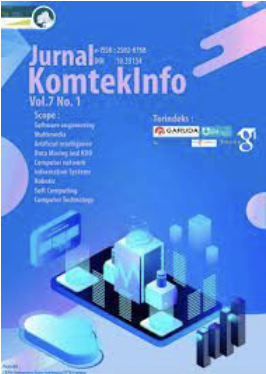Shortest Path Navigation Optimization using Algorithm A* in GPS-Based Augmented Reality Visualization
DOI:
https://doi.org/10.35134/komtekinfo.v12i3.654Keywords:
Augmented RealityAbstract
The development of digital technology in the Society 5.0 era encourages the integration of technology-based solutions in various fields, including higher education. Ibnu Sina University faces challenges in providing informative and accurate access to campus navigation, especially for new students and visitors. The lack of a directional system and the absence of a digital map of the campus cause difficulties in finding service locations such as the rectorate, academic room, or finance department. Conventional technologies such as Google Maps have not been able to provide specific navigation in the campus environment due to the limitations of internal building mapping. This research aims to develop a campus navigation system based on Augmented Reality (AR) and Global Positioning System (GPS) that is optimized with the A* (A-Star) algorithm for the determination of the shortest path. AR technology is used to display visual directions in real-time in a real environment through a smartphone camera. GPS plays a role in determining the user's position, while the A* algorithm calculates the shortest route based on the structure of the campus location graph using a heuristic approach. The development method used is the Multimedia Development Life Cycle (MDLC) which consists of six stages: concept, design, material collecting, assembly, testing, and distribution. Data collection was carried out through direct observation, interviews with the campus, and recording 14 coordinate points of campus service locations using Google Earth. The system is built using the Unity platform with support from the AR Foundation and ARLocation, as well as the A* implementation in route search. The results of this research are able to provide a more efficient, accurate, and interactive campus navigation solution. This system not only supports the convenience of users in finding a location, but also becomes an innovation in the development of campus services based on digital technology.
References
V. Anggaresta, D. Wahyu Wibowo, M. Shulhan Khairy, P. Studi Teknik Informatika, J. Teknologi Informasi, and P. Negeri Malang, “Implementasi Teknologi Augmented Reality Untuk Navigasi Pada Area Kantor Pemerintahan Kabupaten Mojokerto,” 2024.
Muhammad Reyhandi Akbar, Ilka Zufria, and Aninda Muliani Harahap, “Implementasi Algoritma A Star Pada Sistem Informasi Geografis Sekolah Luar Biasa di Kota Medan,” Journal of Computers and Digital Business, vol. 3, no. 1, pp. 18–25, Jan. 2024, doi: 10.56427/jcbd.v3i1.243.
I. S. Wijaya, G. Ramadhan, and M. Masgo, “Aplikasi Edukasi Pengenalan Bahasa Arab Berbasis Augmented Reality Studi Kasus : Madrasah Ardhal-Haq,” JTIM : Jurnal Teknologi Informasi dan Multimedia, vol. 6, no. 3, pp. 271–282, Sep. 2024, doi: 10.35746/jtim.v6i3.523.
A. Beni Santoso, “ANALISIS PENGGUNAAN TEKNOLOGI AUGMENTED REALITY DALAM PELATIHAN KETERAMPILAN KERJA INDUSTRI,” May 2024.
B. Setiawan, A. Gustalika, and A. Raharja, “Rancang Bangun Media Pembelajaran Tumbuhan berbasis Augmented Reality dengan Metode MDLC,” Bulletin of Information Technology (BIT), vol. 5, no. 2, pp. 91–101, 2024, doi: 10.47065/bit.v5i2.1325.
D. Hidayat, D. Setiawan, and D. Arisandi, “Aplikasi Visualisasi Pembangunan Jalan Baru Menggunakan Augmented Reality,” 2023.
A. D. Maharani, M. Erythrea Nur Islami, and H. Hermawan, “Augmented Reality dan Pengalaman Wisata,” Jurnal Kajian Pariwisata, vol. 6, no. 1, pp. 64–74, Jul. 2024, doi: 10.51977/jiip.v6i1.1654.
st Arya Prayogi Utama, nd Mujib Ridwan, and rd Muhammad Andik Izzuddin UIN Sunan Ampel Surabaya Surabaya, “Development of an Augmented Reality (AR)-Based Indoor Navigation Application for Evacuation and Emergency Handling in UIN Sunan Ampel Surabaya Building,” 2024. [Online]. Available: https://ijcis.net/index.php/ijcis/index
E. S. Pane and S. Samsudin, “Penerapan Algoritma A* (Star) pada Lokasi Cafe Instagramable di Kota Binjai Berbasis Android,” Jurnal Teknologi Sistem Informasi dan Aplikasi, vol. 7, no. 3, pp. 1063–1071, Jul. 2024, doi: 10.32493/jtsi.v7i3.41917.
M. Tryastie, L. Nelda, R. Priskila, and V. Handrianus Pranatawijaya, “Implementasi Algoritma A* (Star) untuk Menentukan Rute Jarak Terpendek,” JNATIA, vol. 2, no. 3, 2024.
C. Husada, K. Dwi Hartomo, H. Prillysca Chernovita, J. Sistem Informasi, F. Teknologi Informasi, and U. Kristen Satya Wacana, “Implementasi Haversine Formula untuk Pembuatan SIG Jarak Terdekat ke RS Rujukan COVID-19,” masa berlaku mulai, vol. 1, no. 3, pp. 874–883, 2017.
I. Amalia Jaza and Darsiti, “Implementasi Multimedia Development Life Cycle (Mdlc) Pada Aplikasi Media Implementasi Multimedia Development Life Cycle (Mdlc) Pada Aplikasi Media Pembelajaran Budaya Jawa Barat Di Kompepar Giri Harja Jelekong,” vol. 06, no. 02, 2024, doi: 10.54209/jatilima.
R. L. Knoblauch, M. T. Pietrucha, and M. Nitzburg, “Field studies of pedestrian walking speed and start-up time,” Transp Res Rec, vol. 1538, no. 1, pp. 27–38, 1996.
Downloads
Published
How to Cite
Issue
Section
License
Copyright (c) 2025 Jurnal KomtekInfo

This work is licensed under a Creative Commons Attribution 4.0 International License.








